Search Result
Results for "
aortic
" in MedChemExpress (MCE) Product Catalog:
1
Biochemical Assay Reagents
4
Isotope-Labeled Compounds
| Cat. No. |
Product Name |
Target |
Research Areas |
Chemical Structure |
-
- HY-B0661
-
-

-
- HY-N9005
-
|
|
Others
|
Cardiovascular Disease
|
|
Dysolenticin J has potent vasodilative effects on aortic rings. Dysolenticin J is an alkaloid that can be isolated from Dysoxylum lenticellatum .
|
-

-
- HY-120164
-
-
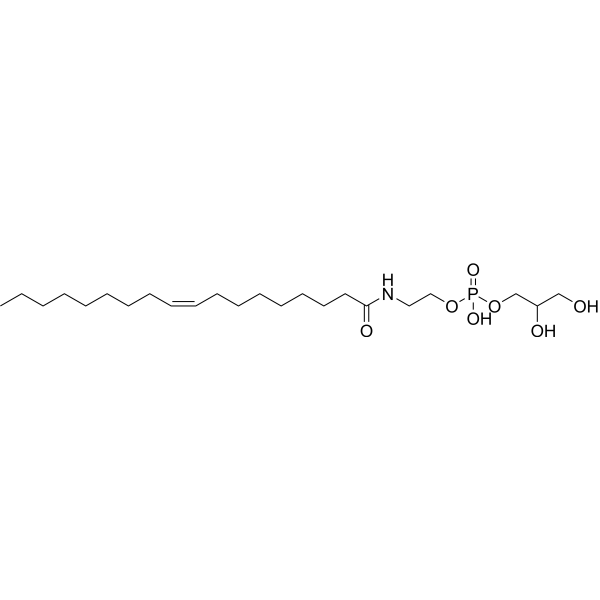
-
- HY-161290
-
-
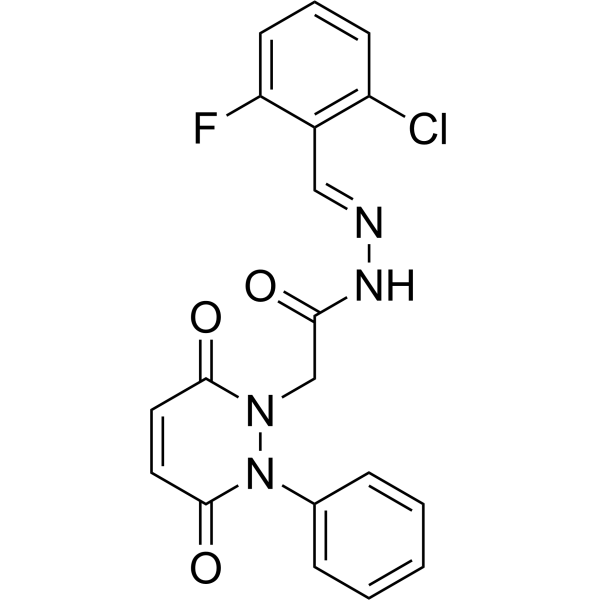
-
- HY-129665
-
|
(±)-O,O-Dimethylcoclaurine
|
Endogenous Metabolite
|
Metabolic Disease
|
|
GS 389 ((±)-O,O-Dimethylcoclaurine) is a tetrahydroisoquinoline. GS-389 inhibites Cyclic AMP and cyclic AMP dependent phosphodiesterases from rat atrial and ventricular tissue. GS-389 relaxes the contraction induced by phenylephrine and high K + in rat aortic rings .
|
-

-
- HY-162387
-
-
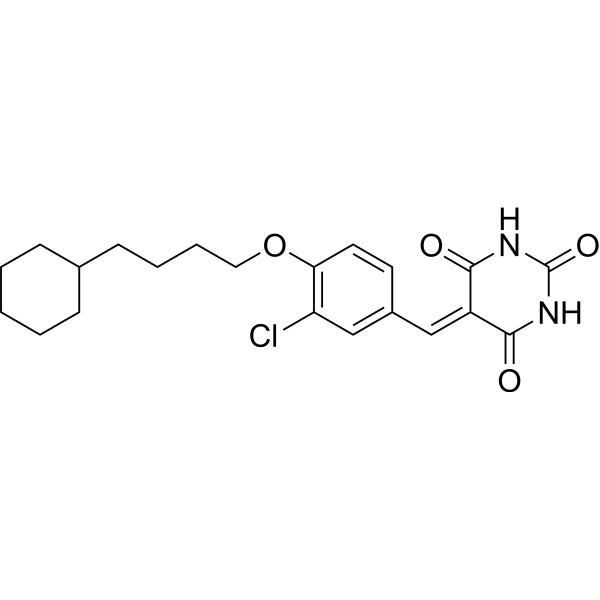
-
- HY-129440
-
|
|
PDGFR
|
Metabolic Disease
Inflammation/Immunology
|
|
N-(p-Coumaroyl) Serotonin is a polyphenol isolated from the seeds of safflower and has antioxidative, anti-atherogenic and anti-inflammatory properties. N-(p-Coumaroyl) Serotonin inhibits PDGF-induced on phosphorylation of PDGF receptor and Ca 2+ release from sarcoplasmic reticulum . N-(p-Coumaroyl) Serotonin ameliorates atherosclerosis and distensibility of the aortic wall in vivo and is usually used for the atherosclerosis research .
|
-
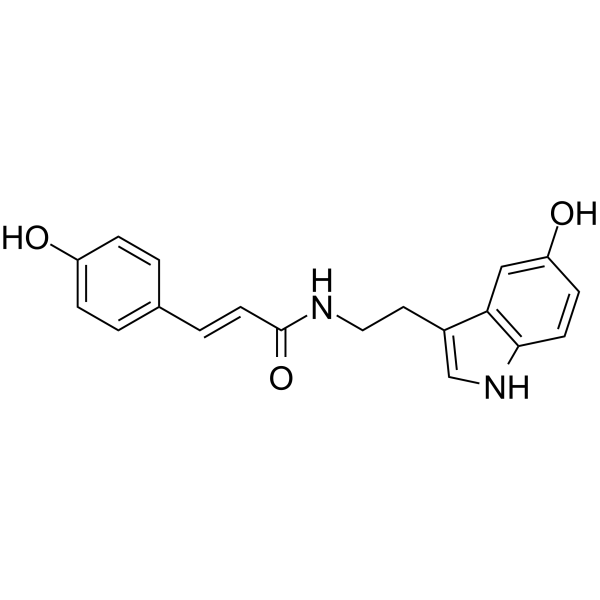
-
- HY-107637
-
|
|
MMP
|
Cardiovascular Disease
|
|
ONO-4817 is a potent inhibitor of matrix metalloproteinase (MMP). Inhibition of matrix metalloproteinases (MMPs) is expected to suppress atherosclerotic neointimal proliferation and thus limits atheromatous plaque progression. ONO-4817 suppresses the development of aortic intimal hyperplasia in experimental hyperlipidemic rabbit .
|
-

-
- HY-103265
-
|
FPL 67156 trisodium
|
Phosphatase
|
Cardiovascular Disease
Inflammation/Immunology
|
|
ARL67156 (FPL 67156) trisodium is a selective small molecular inhibitor, targeting to ecto-ATPase, CD39, and CD73. ARL67156 trisodium is also a competitive inhibitor of NTPDase1 (CD39), NTPDase3 and NPP1, with Kis of 11, 18 and 12?μM, respectively. ARL67156 trisodium can be used in the research of calcific aortic valve disease, asthma .
|
-
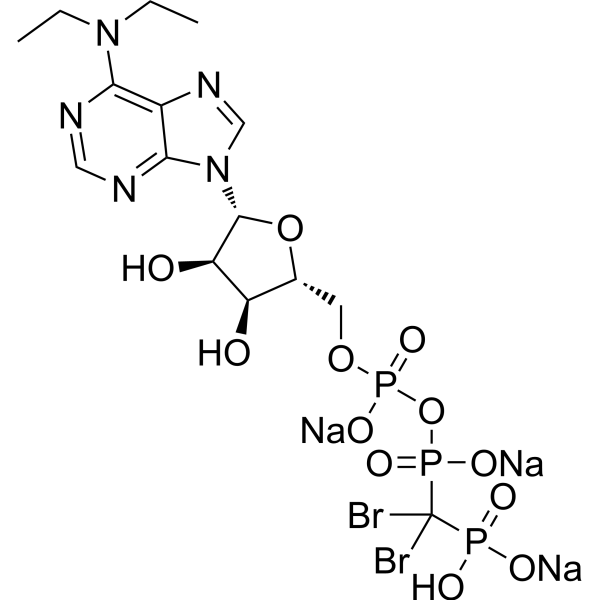
-
- HY-15404
-
|
Lu-135252
|
Endothelin Receptor
|
Cardiovascular Disease
Endocrinology
|
|
Darusentan (Lu-135252) is a selective endothelin receptor A (ET-A) receptor antagonist, which binds with a Ki of 1.4 nM to the ET-A receptor and a Ki of 184 nM to ET-B receptor, respectively with a 100-fold selectivity for ETA rather than ETB receptors . Darusentan competes for radiolabeled endothelin binding in rat aortic vascular smooth muscle cells (RAVSMs) membranes with single-site kinetics, exhibiting a Ki of 13 nM .
|
-
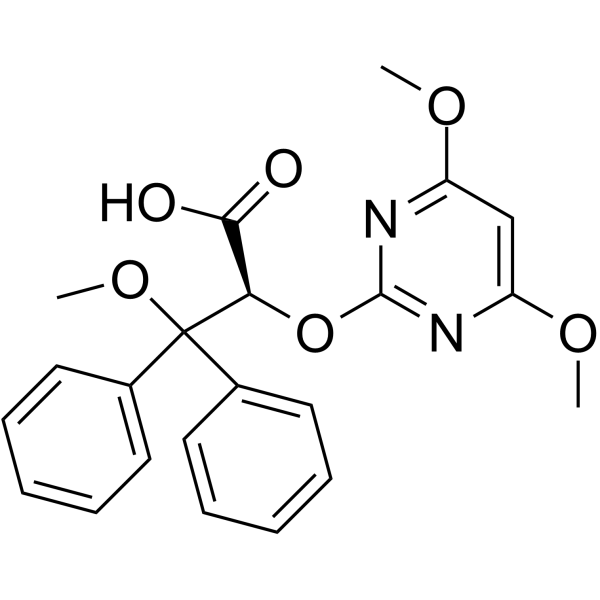
-
- HY-103265B
-
|
FPL 67156 trisodium hydrate
|
Phosphatase
|
Cardiovascular Disease
Inflammation/Immunology
|
|
ARL67156 (FPL 67156) trisodium hydrate is a selective small is a selective samll molecular inhibitor, targeting to ecto-ATPase, CD39, and CD73. ARL67156 trisodium hydrate is also a competitive inhibitor of NTPDase1 (CD39), NTPDase3 and NPP1, with Kis of 11, 18 and 12?μM, respectively. ARL67156 trisodium hydrate can be used in the research of disease like calcific aortic valve disease, asthma .
|
-
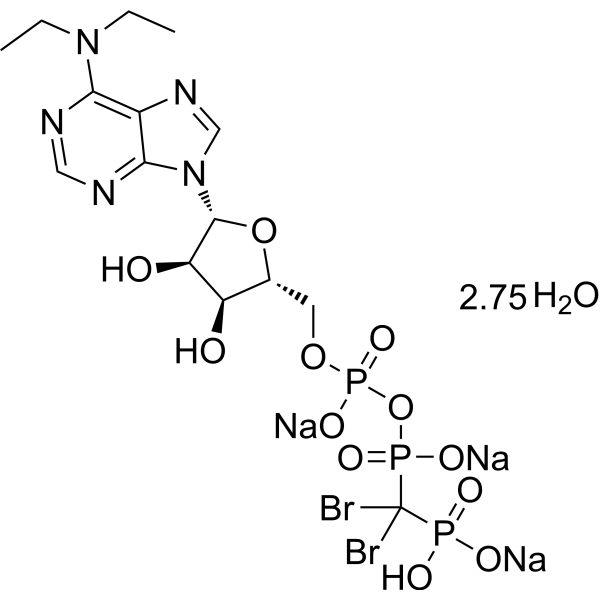
-
- HY-103265D
-
|
FPL 67156 triethylamine
|
Phosphatase
|
Cardiovascular Disease
Inflammation/Immunology
|
|
ARL67156 (FPL 67156) triethylamine is a selective small is a selective samll molecular inhibitor, targeting to ecto-ATPase, CD39, and CD73. ARL67156 triethylamine is also a competitive inhibitor of NTPDase1 (CD39), NTPDase3 and NPP1, with Kis of 11, 18 and 12?μM, respectively. ARL67156 triethylamine can be used in the research of disease like calcific aortic valve disease, asthma .
|
-
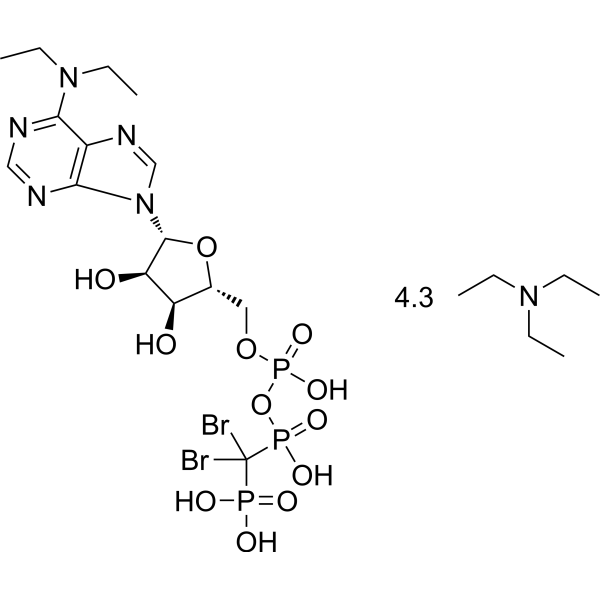
-
- HY-N6660
-
|
Tricaprin; Glyceryl tridecanoate
|
Endogenous Metabolite
Androgen Receptor
|
Metabolic Disease
|
|
Trisdecanoin (Tricaprin; Glyceryl tridecanoate) is an orally available precursor of decanoic acid (DA precursor) that can be hydrolyzed to decanoic acid. Trisdecanoin and its metabolite capric acid not only provide the body with a quick source of energy, but can also affect lipid metabolism. Trisdecanoin is a major component of medium chain triglycerides (MCT), which has preventive or inhibitory properties for abdominal aortic aneurysms (AAA), inhibition of cardiovascular disease, and anti-androgen (NSAA) and anti-hyperglycemic properties. Trisdecanoin can be used as an additive in food, medicine and cosmetics .
|
-
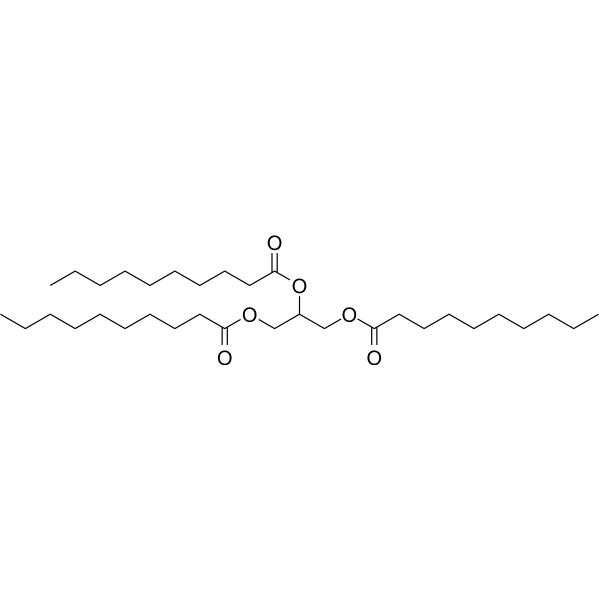
-
- HY-U00135
-
-

-
- HY-N3547
-
|
Cassythine
|
Others
|
Cardiovascular Disease
|
|
Cassyfiline (Cassythine) is an aporphine alkaloid. Cassyfiline has potent vasorelaxing effects on precontracted rat aortic preparations with an IC50 of 0.09 μM .
|
-
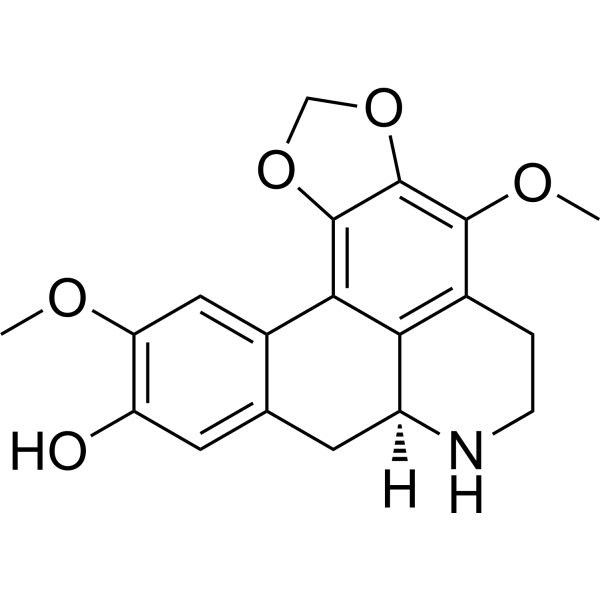
-
- HY-118824A
-
|
(E/Z)-Moschamine
|
Others
|
Cardiovascular Disease
|
|
N-Feruloylserotonin, an antioxidative component and bioactive serotonin derivative, from the Seed of Carthamus tinctorius L., ameliorates atherosclerosis and distensibility of the aortic wall in Kurosawa and Kusanagi-hypercholesterolemic (KHC) rabbits .
|
-

-
- HY-N3202
-
|
(+)-Neolitsine
|
Others
|
Cardiovascular Disease
|
|
Neolitsine ((+)-Neolitsine) is a vasodilator. Neolitsine can be isolated from the herb Cassytha filiformis. Neolitsine exhibits significant vasodilatory effects on precontracted rat aortic preparations with an IC50 of 0.29 μM .
|
-

-
- HY-N0194
-
|
|
Apoptosis
Parasite
|
Inflammation/Immunology
Cancer
|
|
Asiatic acid, a pentacyclic triterpene found in Centella asiatica (Centella asiatica), has anticancer activity. Asiatic acid induces apoptosis in melanoma cells and has barrier protective effects on human aortic endothelial cells (HAEC). Asiatic acid also has anti-inflammatory activity and inhibits tumor necrosis factor (TNF)-α-induced endothelial barrier dysfunction. Asiatic acid also inhibits NLRP3 inflammasome activation and NF-κB pathway, effectively inhibits inflammation in rats, and has neuroprotective effects in rat spinal cord injury (SCI) model .
|
-

-
- HY-B0661A
-
-
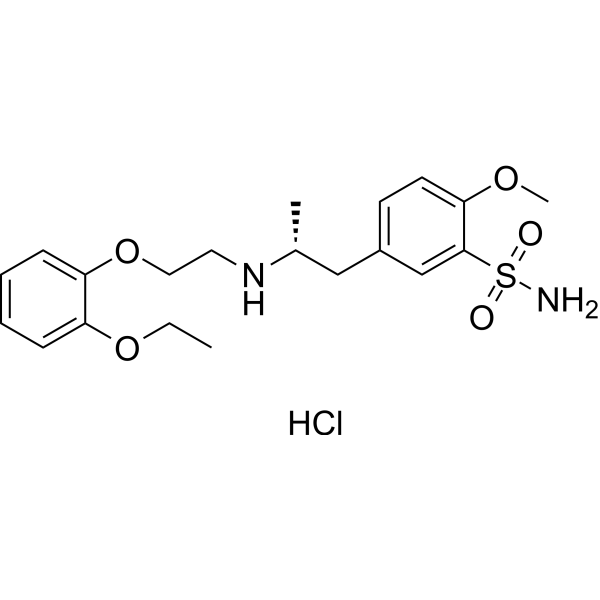
-
- HY-A0117
-
|
Temocapril diacid; Temocaprilate; RS 5139
|
|
|
|
Temocaprilat (Temocapril diacid) is an inhibitor of angiotensin-converting enzyme (ACE). Temocaprilat alleviates the inhibitory effect of high glucose on the proliferation of aortic endothelial cells. Temocaprilat has potential applications in hypertension and vascular inflammation .
|
-

-
- HY-N3063
-
|
|
Others
|
Cardiovascular Disease
|
|
Pimaric acid is a resin acid that has been found in A. cordata and various pines. Pimaric acid reduces mRNA expression, protein levels, and promoter activity of matrix metalloproteinase-9 (MMP-9) in TNF-α-stimulated human aortic smooth muscle cells (HASMCs).
|
-
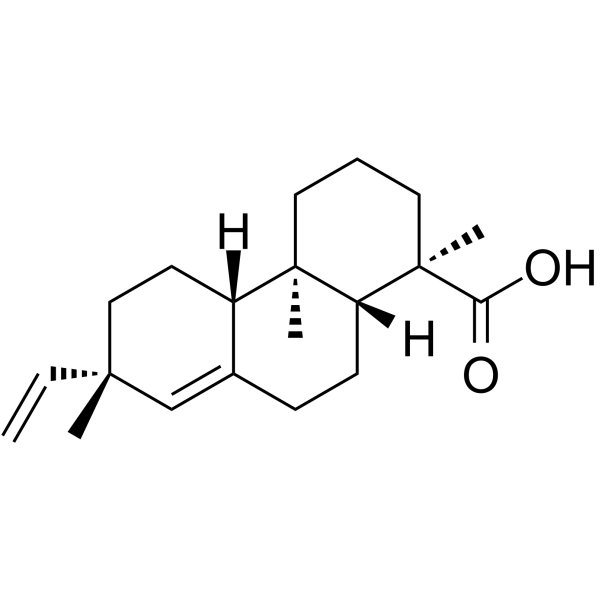
-
- HY-126410
-
|
|
FAK
|
Metabolic Disease
|
|
Petunidin chloride is an O-methylated anthocyanidin derived from delphinidin. Petunidin chloride binds with and suppresses the activity of focal adhesion kinase and to inhibit platelet-derived growth factor-induced aortic smooth muscle cell migration, which may confer a protective effect against atherosclerosis.
|
-
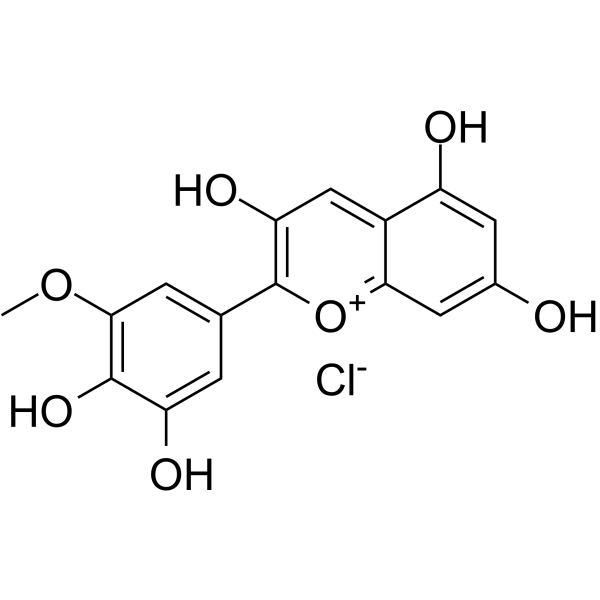
-
- HY-15778A
-
-
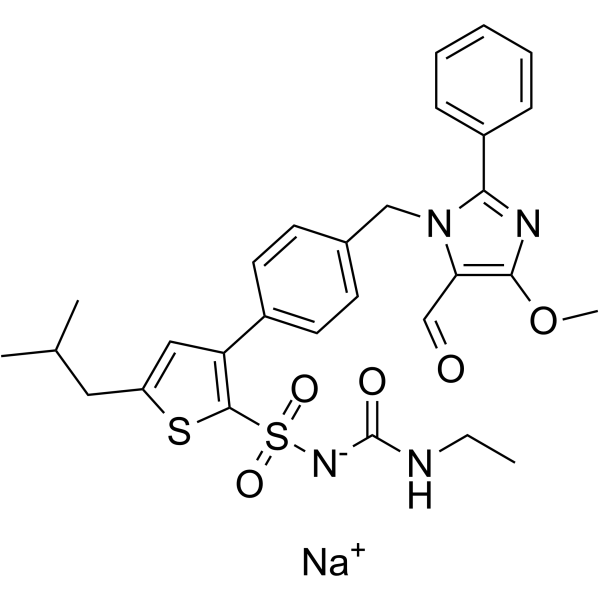
-
- HY-P0049
-
|
Arg8-vasopressin; AVP
|
Vasopressin Receptor
|
Neurological Disease
Cancer
|
|
Argipressin (Arg8-vasopressin) binds to the V1, V2, V3-vascular arginine vasopressin receptor, with a Kd value of 1.31 nM in A7r5 rat aortic smooth muscle cells for V1.
|
-
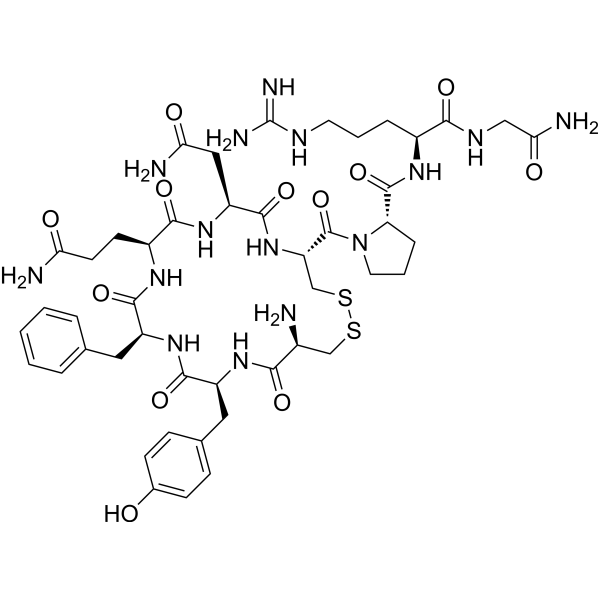
-
- HY-116392A
-
|
|
Glucosylceramide Synthase (GCS)
|
Cancer
|
|
(−)-L-threo-PDMP hydrochloride is the hydrochloride form of (−)-L-threo-PDMP. L-threo-PDMP is a glucosylceramide synthase (GCS) inhibitor. L-threo-PDMP stimulates the proliferation of cultured aortic smooth muscle cells, and that increases the level of LacCer in B16 melanoma cells .
|
-
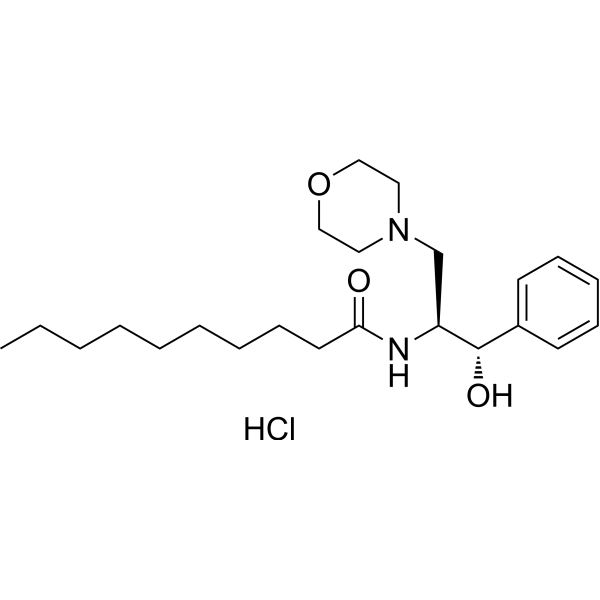
-
- HY-N0177
-
|
|
STAT
MicroRNA
|
Metabolic Disease
|
|
Diosgenin, a steroidal saponin, can inhibit STAT3 signaling pathway . Diosgenin is an exogenous activator of Pdia3/ERp57 . Diosgenin inhibits aortic atherosclerosis progression by suppressing macrophage miR-19b expression .
|
-

-
- HY-B0661AS
-
-

-
- HY-B0661AS1
-
-
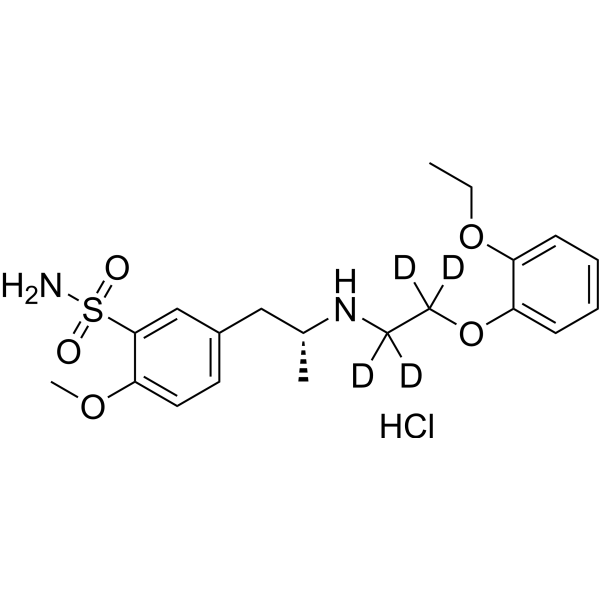
-
- HY-113029
-
-

-
- HY-120986
-
|
(S)-BEL; (S,E)-Bromoenol lactone
|
Phospholipase
|
Inflammation/Immunology
|
|
(S)-Bromoenol lactone ((S)-BEL) is an irreversible, chiral, mechanism-based inhibitor of calcium-independent phospholipase A2β (iPLA2β) that inhibits the vasopressin-induced release of arachidonate from cultured rat aortic smooth muscle (A10) cells with an IC50 of 2 µM .
|
-
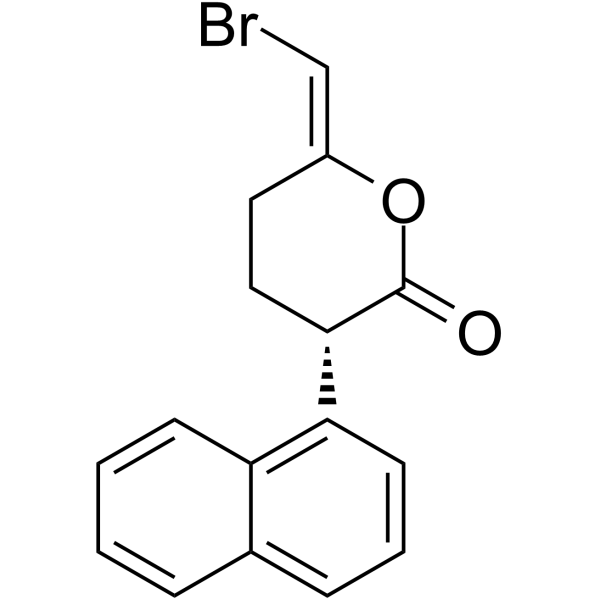
-
- HY-W539944
-
|
Arg8-vasopressin acetate; AVP acetate
|
Vasopressin Receptor
Apoptosis
|
Neurological Disease
|
|
Argipressin (Arg8-vasopressin) (acetate) binds to the V1, V2, V3-vascular arginine vasopressin receptor, with a Kd value of 1.31 nM in A7r5 rat aortic smooth muscle cells for V1 .
|
-

-
- HY-N10881
-
|
|
Others
|
Cardiovascular Disease
|
|
Dihydrocurcumenone is a carabrane-type sesquiterpene. Dihydrocurcumenone can be isolated from Curcuma zedoaria, and the common form is 4-dihydrocurcumenone. Curcuma zedoaria sesquiterpene has vascular relaxation activity. 4-dihydrocurcumenone can inhibit the high concentration of K + induced constriction of isolated rat aortic strips .
|
-

-
- HY-125171
-
|
|
Toll-like Receptor (TLR)
|
Inflammation/Immunology
|
|
IAXO-102 is a TLR4 antagonist which negatively regulates TLR4 signalling. IAXO-102 inhibits MAPK and p65 NF-κB phosphorylation and expression of TLR4 dependent proinflammatory protein. IAXO-102 also prevents experimental abdominal aortic aneurysm development .
|
-
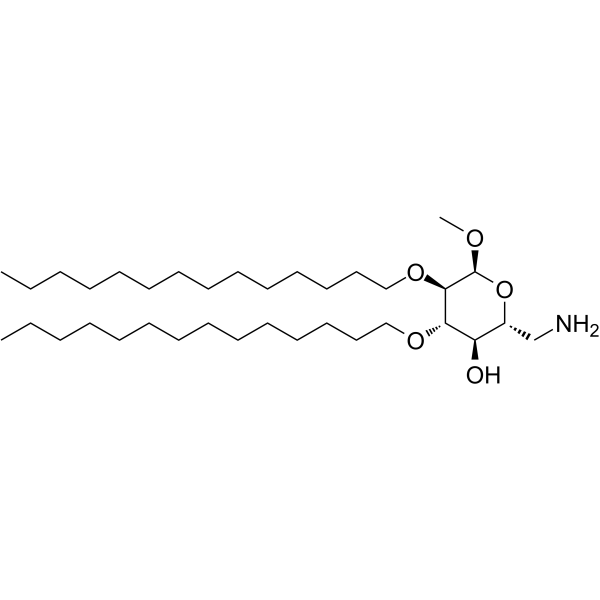
-
- HY-149120
-
|
|
Phospholipase
|
Cardiovascular Disease
Inflammation/Immunology
|
|
ASM-IN-1 is a potent and orally active acid sphingomyelinase (ASM) inhibitor with an IC50 value of 1.5 µM. ASM-IN-1 reduces lipid plaques in the aortic arch and aorta and reduces plasma ceramide concentration and Ox-LDL levels. ASM-IN-1 shows antiatherosclerotic and anti-inflammatory activity .
|
-
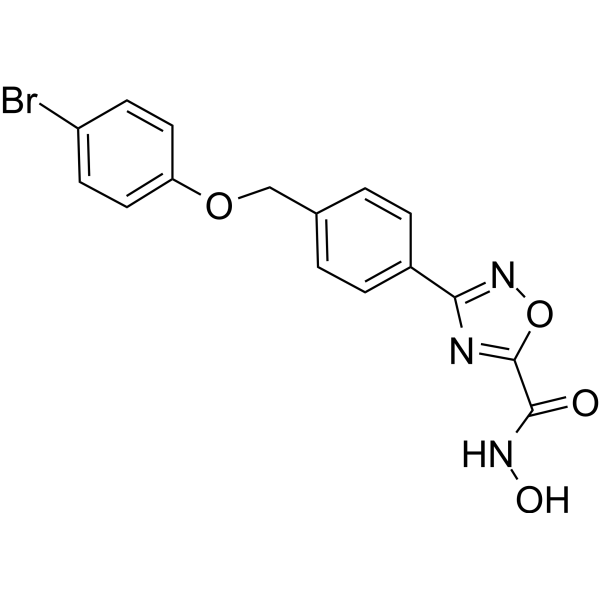
-
- HY-115381
-
|
|
Endogenous Metabolite
|
Cardiovascular Disease
|
|
Lipoxin A5 is an eicosapentaenoic acid derived from pig white blood cells. Lipoxin A5 slowly contracted the guinea pig lung parenchymal strips with a contractile force similar to that of LXA4 and LXB4.2, but LXA5 did not have the vasodilating effect on the aortic smooth muscle shown by LXA4 and LXB4.2 .
|
-
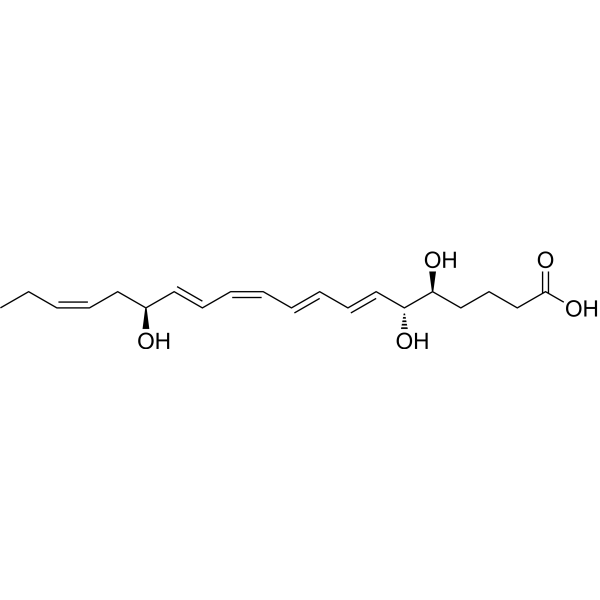
-
- HY-N11538
-
|
|
Others
|
Inflammation/Immunology
|
|
Quercetin-3-O-(2′′-O-galloyl)-β-D-glucopyranoside is a orally active phenolic compound that can be isolated from the Geranium species. Quercetin-3-O-(2′′-O-galloyl)-β-D-glucopyranoside has anti-inflammatory activities and has potential application in edema and aortic endothelium-dependent relaxation injury .
|
-

-
- HY-103291
-
|
|
Bradykinin Receptor
|
Inflammation/Immunology
Endocrinology
|
|
Sar-[D-Phe8]-des-Arg9-Bradykinin is a agonist of B1 receptor. Sar-[D-Phe8]-des-Arg9-Bradykinin selectively amplifies the contractile response when incubation with human recombinant interleukin-1 β (IL-1 β) in rabbit aortic rings .
|
-
![Sar-[D-Phe8]-des-Arg9-Bradykinin](//file.medchemexpress.com/product_pic/hy-103291.gif)
-
- HY-W005255
-
-
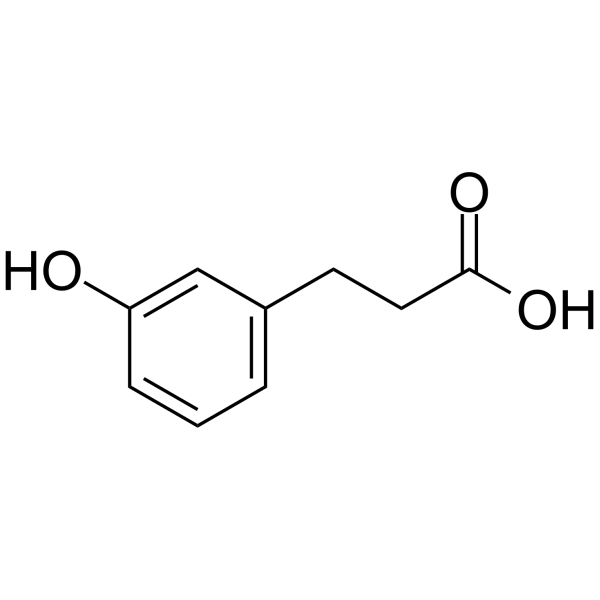
-
- HY-130502
-
|
Cholesterol beta-epoxide
|
Biochemical Assay Reagents
|
Others
|
|
Cholesterol 5beta,6beta-epoxide is an oxidative metabolite of cholesterol formed by free-radical and non-radical oxidation of cholesterol at the 5,6 double bond. Induces lactate dehydrogenase (LDH) release and apoptosis in macrophage-differentiated U937 cells. Cholesterol 5beta,6beta-epoxide has been found in human fatty streaks and advanced atherosclerotic lesions, but not in normal aortic tissue .
|
-
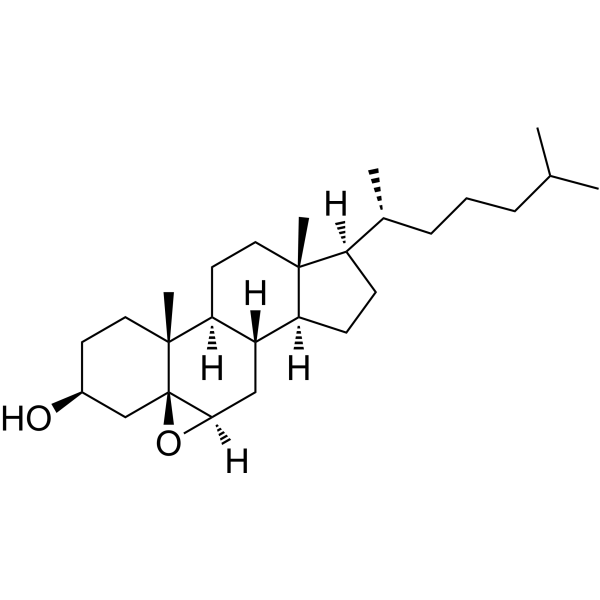
-
- HY-115376
-
|
ZINC08010136
|
Ras
|
Inflammation/Immunology
|
|
Z62954982 (ZINC08010136) is a potent, selective and cell-permeable Rac1 (IC50=12 μM) inhibitor that is 4 times more effective than NSC23766 (HY-15723A) (IC50=50 μM). Z62954982 disrupts the Rac1/Tiam1 complex and decreases cytoplasmic levels of active Rac1 (GTP-bound Rac1), without affecting the activity of other Rho GTPases (such as Cdc42 or RhoA) .
|
-
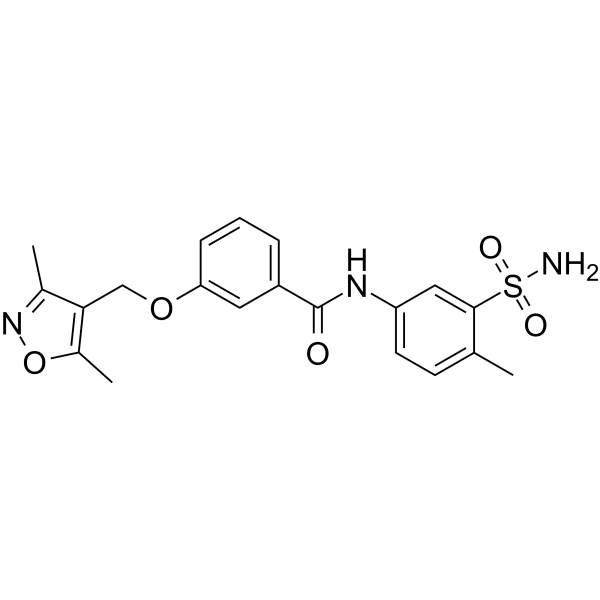
-
- HY-123468
-
|
|
Cyclic GMP-AMP Synthase
PKA
ERK
|
Cardiovascular Disease
Metabolic Disease
|
|
HA-1004 is a selective inhibitor of PKA, which can inhibit lipolysis and induce vascular relaxation. HA-1004 is also a dual inhibitor of cyclic GMP-dependent protein kinase and cyclic AMP-dependent protein, and is involved in smooth muscle, second messenger, cyclic AMP and cyclic GMP regulation mechanisms. HA-1004 can be used as a vasodilator to inhibit the contraction of rabbit aortic strips, or to antagonize ERK and tyrosine hydroxylase (TH) phosphorylation in morphine abstinence rat models .
|
-
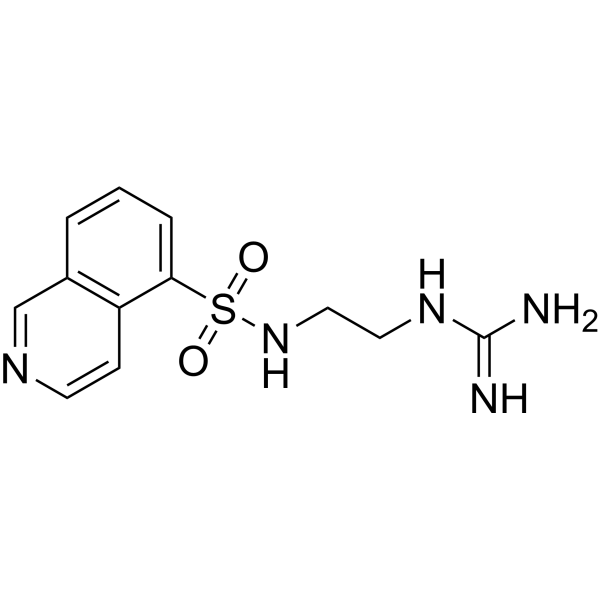
-
- HY-P0175A
-
|
740YPDGFR TFA; PDGFR 740Y-P TFA
|
PI3K
Autophagy
|
Cancer
|
|
740 Y-P TFA is a potent and cell-permeable PI3K activator. 740 Y-P TFA readily binds GST fusion proteins containing both the N- and C- terminal SH2 domains of p85 but fails to bind GST alone .
|
-

-
- HY-P0190A
-
|
|
Potassium Channel
|
Others
|
|
Iberiotoxin (TFA) is a selective high conductance high conductance Ca 2+-activated K + channel inhibitor with a Kd of ~1 nM. Iberiotoxin (TFA) does not block other types of voltage-dependent ion channels .
|
-

-
- HY-N2673
-
|
5-n-Heptadecylresorcinol; AR-C17
|
Sirtuin
|
Cardiovascular Disease
Metabolic Disease
|
|
5-Heptadecylresorcinol (AR-C17), a phenolic lipid component, is also an orally active mitochondrial protector. 5-Heptadecylresorcinol improves mitochondrial function via sirtuin3 signaling pathway, thus alleviates endothelial cell damage and apoptosis. 5-Heptadecylresorcinol induces sirtuin3-mediated autophagy. 5-Heptadecylresorcinol reduces the atherosclerotic plaques in the aortic root region of mice heart. 5-Heptadecylresorcinol can be used for research of atherosclerosis prevention and obesity .
|
-

-
- HY-16768
-
|
QAW039; NVP-QAW039
|
Prostaglandin Receptor
|
Cardiovascular Disease
|
|
Fevipiprant (QAW039, NVP-QAW039) is s an orally active, selective, reversible prostaglandin D2 (DP2) receptor antagonist with an Kd value of 1.14 nM. Fevipiprant has the potential for the research of bronchial asthma .
|
-

-
- HY-120272
-
|
DT-1154
|
Phosphatase
|
Cancer
|
|
SMAP-2 (DT-1154) is an orally active protein phosphatase 2A (PP2A) activator, with anti-cancer activity .
|
-
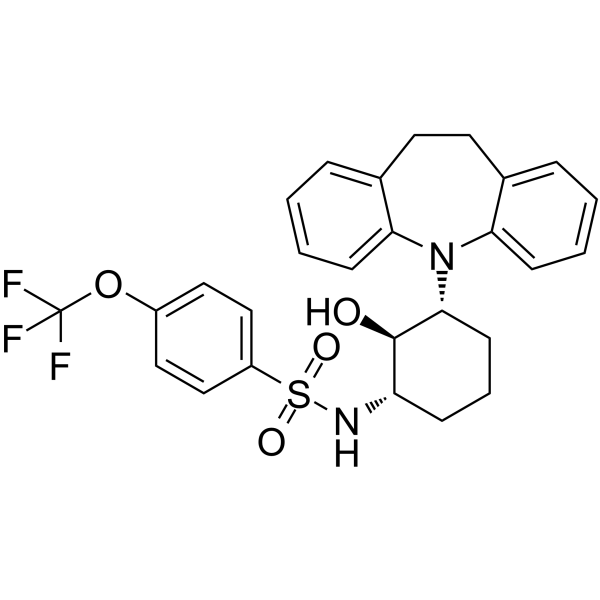
-
- HY-112499
-
|
Vitamin K2-7; Vitamin K2(35); Vitamin MK-7
|
Others
|
Cardiovascular Disease
|
|
Menaquinone-7 (Vitamin K2-7), belongs to a class of K2-vitamin homologs (orally active), is originally discovered as the anti-hemorrhagic factors. Menaquinone-7 inhibits osteoclast bone resorption in vitro and stimulates bone formation in femoral tissue of aged female rats. Menaquinone-7 has a well-researched potential in the prevention of aging-induced bone degeneration. Menaquinone-7 is also a pharmacological option for activating Gla matrix protein and intervening in the progression of calcific aortic stenosis (CAVS) .
|
-
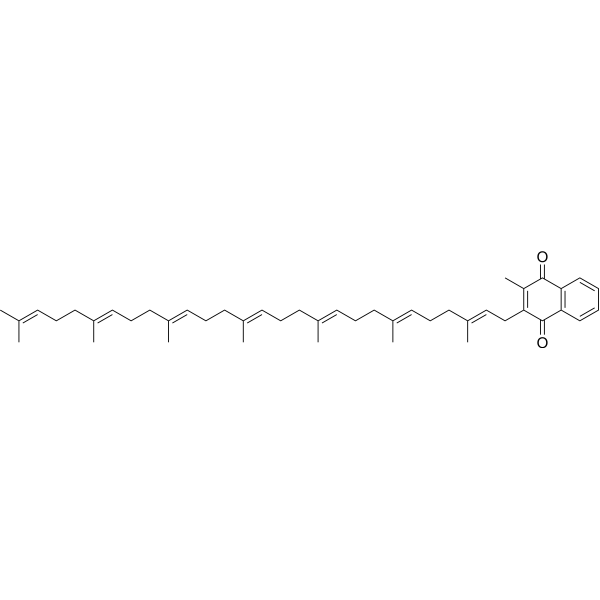
-
- HY-112499S
-
|
Vitamin K2-7-d7; Vitamin K2(35)-d7; Vitamin MK-7-d7
|
Isotope-Labeled Compounds
|
Cardiovascular Disease
|
|
Menaquinone-7-d7 is the deuterium labeled Menaquinone-7. Menaquinone-7 (Vitamin K2-7), belongs to a class of K2-vitamin homologs, is originally discovered as the anti-hemorrhagic factors[1]. Menaquinone-7 (Vitamin K2-7) is identified as the most bioactive cofactor for the carboxylation reaction of Gla-proteins [2]. Supplementation with Menaquinone-7 (Vitamin K2-7) is a pharmacological option for activating matrix Gla protein and intervening in the progression of calcific aortic valve stenosis (CAVS)[3].
|
-

-
- HY-112499S1
-
|
Vitamin K2-7-13C6; Vitamin K2(35)-13C6; Vitamin MK-7-13C6
|
Isotope-Labeled Compounds
|
Cardiovascular Disease
|
|
Menaquinone-7- 13C6 is the 13C-labeled Menaquinone-7. Menaquinone-7 (Vitamin K2-7), belongs to a class of K2-vitamin homologs, is originally discovered as the anti-hemorrhagic factors[1]. Menaquinone-7 (Vitamin K2-7) is identified as the most bioactive cofactor for the carboxylation reaction of Gla-proteins [2]. Supplementation with Menaquinone-7 (Vitamin K2-7) is a pharmacological option for activating matrix Gla protein and intervening in the progression of calcific aortic valve stenosis (CAVS)[3].
|
-

-
- HY-A0119
-
|
Sodium nitroprusside dihydrate; Sodium Nitroferricyanide(III) Dihydrate
|
Autophagy
|
Cardiovascular Disease
Cancer
|
|
Nitroprusside disodium dehydrate (Sodium nitroprusside dihydrate) is a vasodilator that available for the research of acute hypertension, heart failure. Nitroprusside disodium dehydrate induces autophagy in glutathione-depleted osteoblasts. Nitroprusside disodium dehydrate acts as a nitric oxide (NO) donor in a rat intestinal ischemia reperfusion model .
|
-

- HY-112499R
-
|
Vitamin K2-7(Standard); Vitamin K2(35)(Standard); Vitamin MK-7 (Standard)
|
Others
|
Cardiovascular Disease
|
|
Menaquinone-7 (Standard) is the analytical standard of Menaquinone-7. This product is intended for research and analytical applications. Menaquinone-7 (Vitamin K2-7), belongs to a class of K2-vitamin homologs (orally active), is originally discovered as the anti-hemorrhagic factors. Menaquinone-7 inhibits osteoclast bone resorption in vitro and stimulates bone formation in femoral tissue of aged female rats. Menaquinone-7 has a well-researched potential in the prevention of aging-induced bone degeneration. Menaquinone-7 is also a pharmacological option for activating Gla matrix protein and intervening in the progression of calcific aortic stenosis (CAVS) .
|
-
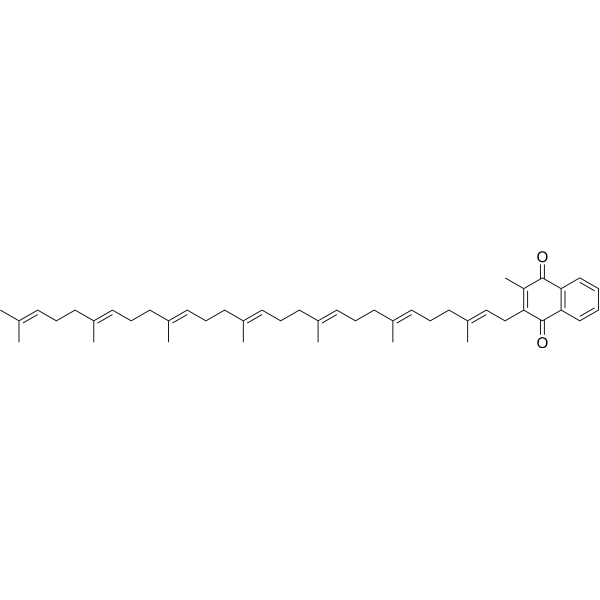
- HY-P0175
-
740 Y-P
Maximum Cited Publications
126 Publications Verification
740YPDGFR; PDGFR 740Y-P
|
PI3K
Autophagy
|
Cancer
|
|
740 Y-P (740YPDGFR; PDGFR 740Y-P) is a potent and cell-permeable PI3K activator. 740 Y-P readily binds GST fusion proteins containing both the N- and C- terminal SH2 domains of p85 but fails to bind GST alone .
|
-

- HY-D1635
-
|
Biotin-XX-SSE
|
Fluorescent Dye
|
Infection
|
|
Sulfo-NHS-LC-LC-Biotin (Biotin-XX-SSE), a biotin reagent, is used to label the proteins exposed to the external leaflet of intact exosomes and contains a larger spacer arm between the biotin and amine reactive linker. The size of this linker helps to overcome steric hindrance and increases labeling efficiency at the crowded exosome surface .
|
-
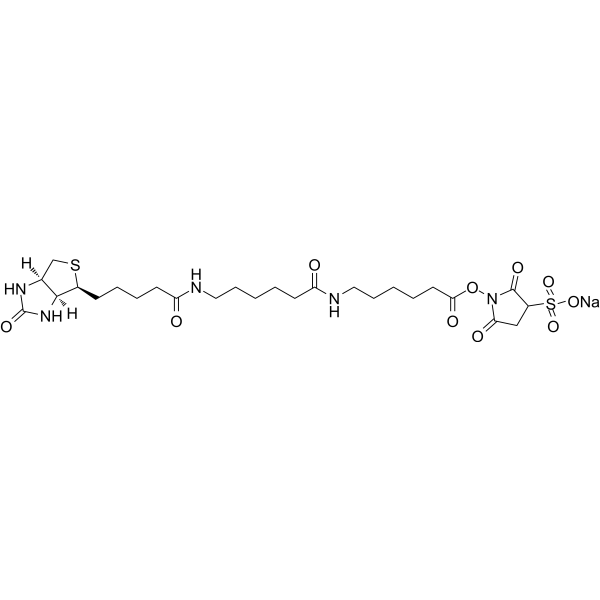
- HY-Y1750A
-
-

- HY-76779
-
|
|
Others
|
Cancer
|
|
4-(Chloromethyl)-7-hydroxycoumarin (compound 4) is a hydroxycoumarin derivative with potent antioxidant effect and high hydroxyl radical-scavenging property. 4-(Chloromethyl)-7-hydroxycoumarin contains a methyl group and a chlorine group in the heterocyclic ring. A series of coumarins incorporating hydroxy-, chloro- and/or chloromethyl-moieties has been investigated as potent inhibitors of the zinc enzyme carbonic anhydrase, expecially tumor-associated isoforms CA IX and XII .
|
-

- HY-N1957
-
|
γ-Mangostin
|
5-HT Receptor
COX
Transthyretin (TTR)
|
Metabolic Disease
Inflammation/Immunology
Cancer
|
|
Gamma-Mangostin is a novel competitive 5-hydroxytryptamine 2A (5-HT2A) receptor antagonist and potent epoxidase 2 (COX-2) inhibitor, as well as a transthyroxin protein (TTR) profibrosis inhibitor. Gamma-Mangostin binds to the thyroxine (T4)-binding sites and stabilized the TTR tetramer . Gamma-Mangostin inhibits [3 H] spiperone binding to cultured rat aortic myocytes (IC50=3.5 nM) and reduces The perfusion pressure response of rat coronary artery to 5-HT2A (IC50=0.32 μM). Gamma-Mangostin has anti-inflammatory, antibacterial, antioxidant and anticancer activities, and can be used in the study of metabolic disorders such as diabetes .
|
-

| Cat. No. |
Product Name |
Type |
-
- HY-130502
-
|
Cholesterol beta-epoxide
|
Biochemical Assay Reagents
|
|
Cholesterol 5beta,6beta-epoxide is an oxidative metabolite of cholesterol formed by free-radical and non-radical oxidation of cholesterol at the 5,6 double bond. Induces lactate dehydrogenase (LDH) release and apoptosis in macrophage-differentiated U937 cells. Cholesterol 5beta,6beta-epoxide has been found in human fatty streaks and advanced atherosclerotic lesions, but not in normal aortic tissue .
|
| Cat. No. |
Product Name |
Target |
Research Area |
-
- HY-P0049
-
|
Arg8-vasopressin; AVP
|
Vasopressin Receptor
|
Neurological Disease
Cancer
|
|
Argipressin (Arg8-vasopressin) binds to the V1, V2, V3-vascular arginine vasopressin receptor, with a Kd value of 1.31 nM in A7r5 rat aortic smooth muscle cells for V1.
|
-
- HY-P1949A
-
|
|
Peptides
|
Cardiovascular Disease
Cancer
|
|
Cyclic MKEY TFA is a synthetic cyclic peptide inhibitor of CXCL4-CCL5 heterodimer formation, which protects against atherosclerosis and aortic aneurysm formation by mediating inflammation. Cyclic MKEY TFA also protects against stroke-induced brain injury in mice .
|
-
- HY-P5521
-
|
|
Peptides
|
Cardiovascular Disease
|
|
mLR12 is a Trem1 inhibitory peptide. mLR12 decreases aortic rupture rate in BAPN-induced Thoracic aortic aneurysm and dissection (TAAD) mice model .
|
-
- HY-P1949
-
|
|
Peptides
|
Cardiovascular Disease
Cancer
|
|
Cyclic MKEY is a synthetic cyclic peptide inhibitor of CXCL4-CCL5 heterodimer formation, which protects against atherosclerosis and aortic aneurysm formation by mediating inflammation. Cyclic MKEY also protects against stroke-induced brain injury in mice .
|
-
- HY-W539944
-
|
Arg8-vasopressin acetate; AVP acetate
|
Vasopressin Receptor
Apoptosis
|
Neurological Disease
|
|
Argipressin (Arg8-vasopressin) (acetate) binds to the V1, V2, V3-vascular arginine vasopressin receptor, with a Kd value of 1.31 nM in A7r5 rat aortic smooth muscle cells for V1 .
|
-
- HY-103291
-
|
|
Bradykinin Receptor
|
Inflammation/Immunology
Endocrinology
|
|
Sar-[D-Phe8]-des-Arg9-Bradykinin is a agonist of B1 receptor. Sar-[D-Phe8]-des-Arg9-Bradykinin selectively amplifies the contractile response when incubation with human recombinant interleukin-1 β (IL-1 β) in rabbit aortic rings .
|
-
- HY-P0175A
-
|
740YPDGFR TFA; PDGFR 740Y-P TFA
|
PI3K
Autophagy
|
Cancer
|
|
740 Y-P TFA is a potent and cell-permeable PI3K activator. 740 Y-P TFA readily binds GST fusion proteins containing both the N- and C- terminal SH2 domains of p85 but fails to bind GST alone .
|
-
- HY-P0190A
-
|
|
Potassium Channel
|
Others
|
|
Iberiotoxin (TFA) is a selective high conductance high conductance Ca 2+-activated K + channel inhibitor with a Kd of ~1 nM. Iberiotoxin (TFA) does not block other types of voltage-dependent ion channels .
|
-
- HY-P0175
-
740 Y-P
Maximum Cited Publications
126 Publications Verification
740YPDGFR; PDGFR 740Y-P
|
PI3K
Autophagy
|
Cancer
|
|
740 Y-P (740YPDGFR; PDGFR 740Y-P) is a potent and cell-permeable PI3K activator. 740 Y-P readily binds GST fusion proteins containing both the N- and C- terminal SH2 domains of p85 but fails to bind GST alone .
|
| Cat. No. |
Product Name |
Category |
Target |
Chemical Structure |
-
- HY-B0661
-
-

-
- HY-129440
-
-

-
- HY-N6660
-
|
Tricaprin; Glyceryl tridecanoate
|
Ketones, Aldehydes, Acids
Source classification
umbellularia californica
Metabolic Disease
Plants
Lauraceae
Disease Research Fields
|
Endogenous Metabolite
Androgen Receptor
|
|
Trisdecanoin (Tricaprin; Glyceryl tridecanoate) is an orally available precursor of decanoic acid (DA precursor) that can be hydrolyzed to decanoic acid. Trisdecanoin and its metabolite capric acid not only provide the body with a quick source of energy, but can also affect lipid metabolism. Trisdecanoin is a major component of medium chain triglycerides (MCT), which has preventive or inhibitory properties for abdominal aortic aneurysms (AAA), inhibition of cardiovascular disease, and anti-androgen (NSAA) and anti-hyperglycemic properties. Trisdecanoin can be used as an additive in food, medicine and cosmetics .
|
-

-
- HY-N9005
-
-

-
- HY-129665
-
-

-
- HY-N3547
-
-

-
- HY-118824A
-
-

-
- HY-N3202
-
-

-
- HY-N0194
-
-

-
- HY-B0661A
-
-

-
- HY-126410
-
-

-
- HY-N0177
-
-

-
- HY-N10881
-
-

-
- HY-N11538
-
-

-
- HY-W005255
-
-

-
- HY-N2673
-
|
5-n-Heptadecylresorcinol; AR-C17
|
Structural Classification
Gramineae
Source classification
Secale cereale
Phenols
Polyphenols
Plants
|
Sirtuin
|
|
5-Heptadecylresorcinol (AR-C17), a phenolic lipid component, is also an orally active mitochondrial protector. 5-Heptadecylresorcinol improves mitochondrial function via sirtuin3 signaling pathway, thus alleviates endothelial cell damage and apoptosis. 5-Heptadecylresorcinol induces sirtuin3-mediated autophagy. 5-Heptadecylresorcinol reduces the atherosclerotic plaques in the aortic root region of mice heart. 5-Heptadecylresorcinol can be used for research of atherosclerosis prevention and obesity .
|
-

-
- HY-Y1750A
-
-

-
- HY-N1957
-
-

| Cat. No. |
Compare |
Product Name |
Species |
Source |
Compare Products
|
| Products |
|
| Cat. No. |
|
| Species |
|
| Source |
|
| Tag |
|
| Accession |
|
| Gene ID |
|
| Molecular Weight |
|
| Purity |
|
| Endotoxin Level |
|
| Biological Activity |
|
| Appearance |
|
| Formulation |
|
| Storage & Stability |
|
| Shipping |
|
| Free Sample |
Yes
No
|
| Size |
* This product has been "discontinued".
Optimized version of product available:
|
| Cat. No. |
Product Name |
Chemical Structure |
-
- HY-112499S1
-
|
|
|
Menaquinone-7- 13C6 is the 13C-labeled Menaquinone-7. Menaquinone-7 (Vitamin K2-7), belongs to a class of K2-vitamin homologs, is originally discovered as the anti-hemorrhagic factors[1]. Menaquinone-7 (Vitamin K2-7) is identified as the most bioactive cofactor for the carboxylation reaction of Gla-proteins [2]. Supplementation with Menaquinone-7 (Vitamin K2-7) is a pharmacological option for activating matrix Gla protein and intervening in the progression of calcific aortic valve stenosis (CAVS)[3].
|
-

-
- HY-B0661AS
-
|
|
|
Tamsulosin-d5 (hydrochloride) is the deuterium labeled Tamsulosin hydrochloride. Tamsulosin hydrochloride ((R)-(-)-YM12617) is an inhibitor of α1-adrenergic receptor. Tamsulosin hydrochloride is used for the research of prostatic hyperplasia. Tamsulosin hydrochloride attenuates abdominal aortic aneurysm growth in animal models[1].
|
-

-
- HY-B0661AS1
-
|
|
|
Tamsulosin-d4 (hydrochloride) is deuterium labeled Tamsulosin (hydrochloride). Tamsulosin hydrochloride ((R)-(-)-YM12617) is an inhibitor of α1-adrenergic receptor. Tamsulosin hydrochloride is used for the research of prostatic hyperplasia. Tamsulosin hydrochloride attenuates abdominal aortic aneurysm growth in animal models[1].
|
-

-
- HY-112499S
-
|
|
|
Menaquinone-7-d7 is the deuterium labeled Menaquinone-7. Menaquinone-7 (Vitamin K2-7), belongs to a class of K2-vitamin homologs, is originally discovered as the anti-hemorrhagic factors[1]. Menaquinone-7 (Vitamin K2-7) is identified as the most bioactive cofactor for the carboxylation reaction of Gla-proteins [2]. Supplementation with Menaquinone-7 (Vitamin K2-7) is a pharmacological option for activating matrix Gla protein and intervening in the progression of calcific aortic valve stenosis (CAVS)[3].
|
-

| Cat. No. |
Product Name |
Application |
Reactivity |
-
- HY-P80484
-
|
alpha sarcomeric Actin; alpha smooth muscle Actin; Actin alpha; ASMA; ASM-A; alpha-SMA; alpha SMA; AAT6; ACTA2; Actin alpha 2 smooth muscle aorta; Actin aortic smooth muscle; ACTSA; ACTVS; Alpha 2 actin; Alpha-actin 2; Cell growth inhibiting gene 46 protein; Growth inhibiting gene 46; ACTA_HUMAN; Actin alpha 2 smooth muscle aorta; Actin aortic smooth muscle; Actin, aortic smooth muscle; Alpha 2 actin; Alpha actin 2; Alpha cardiac actin; Alpha-actin 2; Alpha-actin-2; Cell growth inhibiting gene 46 protein; Cell growth-inhibiting gene 46 protein; Growth inhibiting gene 46; MYMY5 α-Smooth Muscle Actin; α Smooth Muscle Actin
|
WB, IHC-P, FC, IP
|
Human, Mouse |
|
alpha smooth muscle ActinAntibody is a non-conjugated and Rabbit origined monoclonal antibody about 42 kDa, targeting to alpha smooth muscle Actin. It can be used for WB,IHC-P,FC,IP assays with tag free, in the background of Human, Mouse.
|
Your information is safe with us. * Required Fields.
Inquiry Information
- Product Name:
- Cat. No.:
- Quantity:
- MCE Japan Authorized Agent:










































![Sar-[D-Phe8]-des-Arg9-Bradykinin](http://file.medchemexpress.com/product_pic/hy-103291.gif)





















